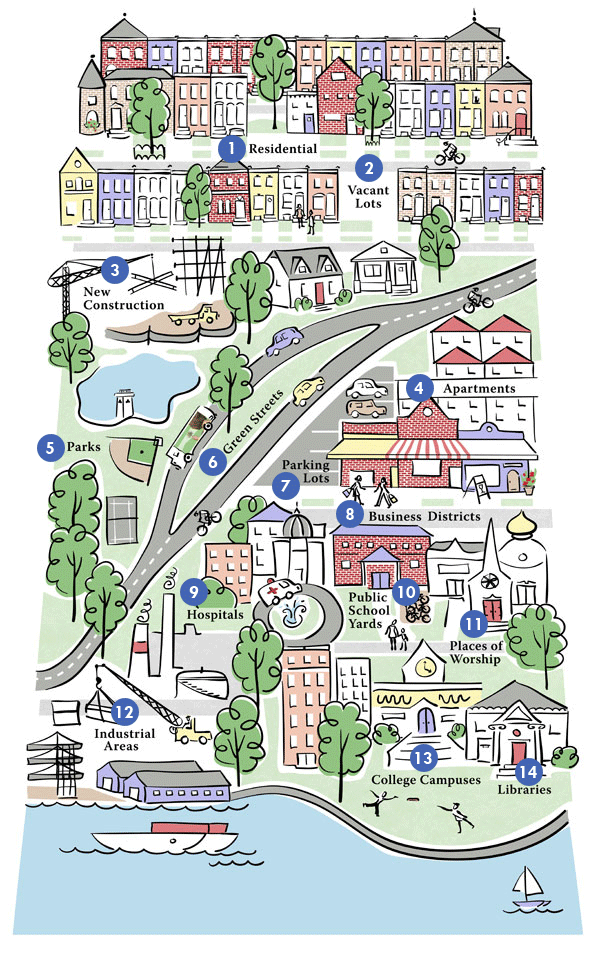Places to Plant Trees
Legend
1. Residential: Baltimore rowhouses and single-family homes make up a significant portion of the City’s land. Grassy front and backyards are great places to plant new trees. Studies show that trees surrounding homes can reduce utility bills and increase property values.
2. Vacant Lots: There are many vacant lots throughout Baltimore City. Some have been adopted by the neighborhoods and made into vibrant gardens. Planting trees in and around gardens is called urban agroforestry. Planting trees in empty lots can indicate that someone cares.
3. New Construction: One of the easiest and most cost-effective ways to lower the impact of construction and improve the environment is to plant trees. Trees slow water runoff, reduce topsoil erosion and prevent harmful pollutants contained in the soil from getting into our waterways.
4. Apartments: Renters have more opportunities to plant and care for trees than they realize. When tenants express interest in helping care for trees, building owners are often willing to invest in planting. The City provides free street trees for empty pits and strips and discount trees for private lawn areas.
5. Parks: Baltimore City Recreation and Parks controls over almost 6,000 acres of parkland. With the help of neighbors and Friends of Parks groups, we host volunteer workdays to plant and maintain trees in our parks and remove invasive vines that threaten our native trees.
6. Medians and Streets: Baltimore has approximately 100,000 trees planted in the right-of-way, along our streets. Tree-lined streets can enhance traffic calming and reduce noise pollution. Baltimore’s trees remove 701 metric tons of pollutants per year, saving almost $4 million dollars annually. Planting trees remains one of the cheapest, most effective ways to clean our air.
7. Parking Lots: Although most parking lots are impervious surfaces such as asphalt, some are green-friendly. These help prevent polluted water from running-off into our streams. Other lots are built with retention systems that help filter out pollutants before then enter the Bay. Medians in parking lots are great places for trees!
8. Business Districts: Trees enhance economic stability by attracting businesses and tourists. People linger and shop longer in business districts with tree-lined streets. Whether planted along sidewalks, on lawn areas or on green rooftops, trees benefit business districts.
9. Hospitals: As centers for healing, hospitals, clinics and community health facilities have an extra incentive to be as comfortable as possible. Trees help grow our urban forest and make healthier, more livable communities. Importantly, studies show that trees can expedite recovery time.
10. Public School Yards: Baltimore has over 200 public schools. Many have large open lawns that are perfect for tree planting. Some schools have unused asphalt surfaces that can be removed and then planted. From rain gardens to lush tree canopy, schools are perfect places to plant and care for trees.
11. Places of Worship: Faith-based organizations own significant amounts of land throughout Baltimore City. Landowners may order discount trees to green up their property. Trees calm and recharge us in our busy lives. They contribute toward creating relaxing, healthy spaces. Trees provide a sense of tranquility that can help us to calm and be still.
12. Industrial Areas: Baltimore’s industrial areas have open tracts of land that can be planted with trees. Also, asphalt can be removed and trees planted. The addition of new trees will improve water quality by absorbing and cleaning runoff. The leaves of trees filter the air by removing dust and absorbing carbon dioxide.
13. College Campuses: Universities own significant amounts of land throughout Baltimore City. These large landowners may order discount trees to green their property. Trees help to cool the city by acting as a natural air conditioner.
14. Libraries: Baltimore City’s public buildings are often bordered by public open space. Trees can be incorporated into areas surrounding our public libraries as well as museums and other open spaces. Large native trees such as oaks and maples and smaller flowering trees like redbud shade and beautify buildings.
